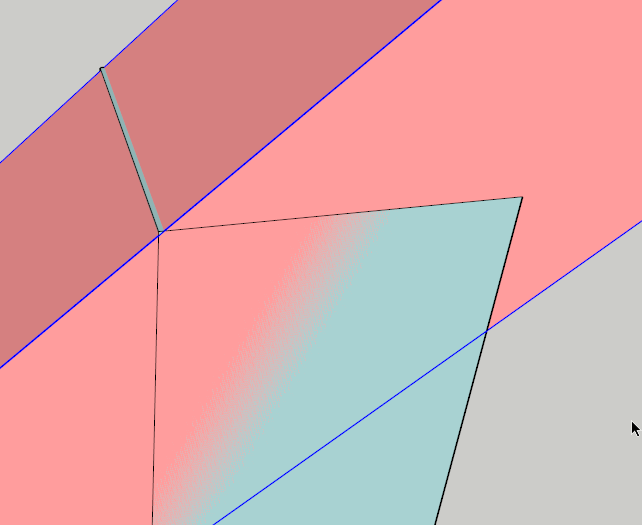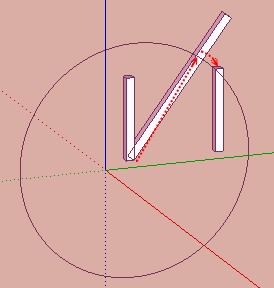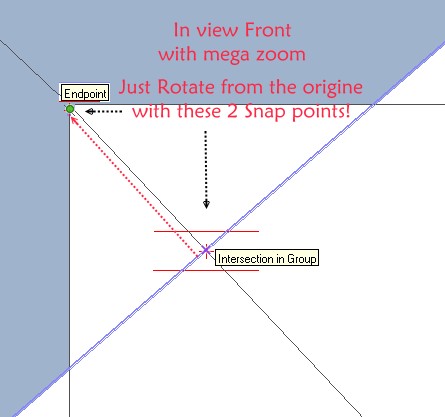Mini-challenge
-
@ely862me said:
Can't do it !! And I'm trying for about 10 minutes now ! lol
haha. right. that's why I thought fredo was nuts at first but then the voodoo kicked in and it snapped perfectly into place
-
I won't quit though ! I'll try again tomorrow ! So, we're still newbie regarding Sketchup
 !
!Have a great one !
-
@moujiik said:
Hi
May be like this?
Moujiik
hmm.. this looks like it's working (as in your results look correct).. i haven't been able to repeat it with my own set of dimensions
 (i think i'm missing something that you're doing) but it seems very closely related to what gilles was suggesting.. i'll have more time a little later to give it a proper examination
(i think i'm missing something that you're doing) but it seems very closely related to what gilles was suggesting.. i'll have more time a little later to give it a proper examination 
-
@tig said:
....You are of course right, in that the width of my 300mm rail when adjusted using my methods is in fact 299.982273mm [the ends are still slightly skewed to the long sides!], but since that 0.0177mm is much thinner than a human hair and only about 1/3rd of the thickness of a Rizla cigarette paper [approaching the limit of human visual acuity!]... and we aren't [usually] designing nanobots or sending someone to Mars - all of these simplified approaches are usually adequate. For how often might we expect to find a piece of wood exactly 300mm wide - even when measured with some uncommonly accurate gauge ?......
Does Rizla still exist?

You are right in that trying to get that extra 0.0001mm (or less) is absolutely ridiculous.
Although it may often look like (when posting here) I am a micron_ or even a nano_freek, I'm most certainly not.
And in daily life I stop at 1mm. I'm even having a hard time distinguishing between these mm_lines when reading measures.
It's just that, like Jeff, I do like SU to get geometry right. To avoid modeling problems later on. So I try to understand what is allowed in the program. And preferably with the most basic toolset. Inferencing is usually doing an excellent job. But it is that construction circle that is just missing in the basic toolset.With this challenge I tried again to come up with a solution, just in case I missed it the thousand times before. No luck other than what others have posted. I can get close, to the point where you cannot even measure the differences. In a few steps. But still, my method doesn't fit into SketchUps accurate inferencing results. It's by manual input.
With one scene to see the rotation point and another (very!) close up scene of the target location. The rough rotation is done by construction, more or less as also shown here by others, the final "accurate" adjustment is done by inputting an angle and retyping a better angle (input goes behond 0.001 degrees). It doesn't take long to get within 0.000001mm, not measurable.At this point SU could be improved with a constuction circle which would not make the program that much heavier. Unlike with true circles.
-
@unknownuser said:
At this point SU could be improved with a constuction circle which would not make the program that much heavier. Unlike with true circles.
I really can't think of much reason as to why the devs wouldn't include this in sketchup.. I guess there would be circumstance when new users might not understand why their points placed along a construction circle may not correspond with their circles but I think that confusion happens anyway when learning to deal with segmented circles to begin with.
but other than this possible confusion, can anyone think of a reason as to why the devs haven't included such a feature?
-
@unknownuser said:
@moujiik said:
Hi
May be like this?
Moujiik
hmm.. this looks like it's working (as in your results look correct).. i haven't been able to repeat it with my own set of dimensions
 (i think i'm missing something that you're doing) but it seems very closely related to what gilles was suggesting.. i'll have more time a little later to give it a proper examination
(i think i'm missing something that you're doing) but it seems very closely related to what gilles was suggesting.. i'll have more time a little later to give it a proper examination 
Let me know if/when you find the correct workflow, please.
Moujiik's presented model does still show some incorrect locations if you zoom in close enough. -
@unknownuser said:
@unknownuser said:
At this point SU could be improved with a constuction circle which would not make the program that much heavier. Unlike with true circles.
I really can't think of much reason as to why the devs wouldn't include this in sketchup.. I guess there would be circumstance when new users might not understand why their points placed along a construction circle may not correspond with their circles but I think that confusion happens anyway when learning to deal with segmented circles to begin with.
but other than this possible confusion, can anyone think of a reason as to why the devs haven't included such a feature?
I'm not against true circles. It may just make the program heavier. Not my concern. But how would SU handle surfaces with true circles and true arcs. There would be much more information to deal with than with "just" a few flat faces. True circles would be awesome though.
You may see this happening in the near future, now that the developing team has their hand free. I think that eventually it's a must for a grown up modeling program. -
@wo3dan said:
I'm not against true circles. It may just make the program heavier. Not my concern. But how would SU handle surfaces with true circles and true arcs. There would be much more information to deal with than with "just" a few flat faces. True circles would be awesome though.
You may see this happening in the near future, now that the developing team has their hand free. I think that eventually it's a must for a grown up modeling program.oh, right.. i'm not thinking they should just make true circles for everything.. (basically turning sketchup into a nurbs app).. a lot of people ask for this but by doing so, some unintended behaviors will come into play.. polygon modelers do have some advantages which will be lost in a nurbs based app..
i think i'm wishing for the same thing you are.. just some construction circles so we can snap to any point along an arc when need be..
but at the same time, there may be a reason why the devs have chosen not to include this feature.. i'm sure they've discussed it plenty of times before.. just curious as to what the reasoning may be..
-
I think Tig's Tangent tools should be a native tool in SU, it's the basis of geometry as I learned it.
-
What about a gizmo?
-
IMPORTANT:
My initial version of LibProtractor.rb for the Target trick was full of bugs. I still need some rework to handle all cases properly and anyway I should revisit this protractor tool.In the meantime, please consider the attached version
to drop into the LIBFREDO6_Dir_44 folderFredo
-
Hi fredo
About your previus try with the normal Rotation tool, have you made a very big zoom on the result ? -
@unknownuser said:
Hi fredo
About your previus try with the normal Rotation tool, have you made a very big zoom on the result ?Pilou,
You're right. The rotation is not accurate and we see a small shift when zooming.
The illusion comes from the fact that, visually from far, we see the edge of the vertical timber.
So it may not be that the standard SU Rotate tool does the job and we may be back to square one

Fredo
-
Damned the trick of jason / Fredo works for me! But....
I had always group that works nut! Never find the "Parallel edges"
But....The secret : explode it!

With group's explosion the rotative block that works like a charm!


Thanks Fredo, my desperation is resolved! Maybe...
Maybe... -
Sorry for the desillusion!

I had the same many times during this crazzy Jeff challenge!
-
Tig's method is some tricky but maybe not very simple

Here without plugin and very easy

Seems 1.000000m everywhere
Circle 100 segments (enter 200)
Just 2 rotations
One general

one with big zoom : That all


Edit
Alas with very very very subatomic zoom
seems top blend becomes no accurate
And the second rotate was not theoricly adapted
-
so, after further examining Moujiik's method, i think he has something there
 …i have a way (doing the same underlying thing as Moujiik showed) which might make it easier to communicate..
…i have a way (doing the same underlying thing as Moujiik showed) which might make it easier to communicate..the thing is, i believe it's still geometrically imperfect but the error must be in the .0000004 (seven decimals) or less range because sketchup keeps reporting it as absolutely perfect (.000000") (in a similar fashion as using math with ruby or a DC can get things perfect within sketchup's maximum precision of six decimals…)
i'll draw up a step by step later tonight so you guys can scrutinize it (and ultimately find the flaw
 )
) -
@unknownuser said:
so, after further examining Moujiik's method, i think he has something there
 …i have a way (doing the same underlying thing as Moujiik showed) which might make it easier to communicate..
…i have a way (doing the same underlying thing as Moujiik showed) which might make it easier to communicate..the thing is, i believe it's still geometrically imperfect but the error must be in the .0000004 (seven decimals) or less range because sketchup keeps reporting it as absolutely perfect (.000000") (in a similar fashion as using math with ruby or a DC can get things perfect within sketchup's maximum precision of six decimals…)
i'll draw up a step by step later tonight so you guys can scrutinize it (and ultimately find the flaw
 )
)How is this different from gilles? (and I posted a similar one a ways back once I saw gilles method - by drawing a perpendicular to the diagonal). This still has an issue of not aligning precisely to the tangents. You can double-check it easily with TIG's true tangent ruby.
-
it's slightly different with what happens with the angles. maybe enough of a difference to bring things within perfect (well, sketchup perfect) .. I'm getting on the train soon.. I'll post something afterwards.
-
@unknownuser said:
it's slightly different with what happens with the angles. maybe enough of a difference to bring things within perfect (well, sketchup perfect) .. I'm getting on the train soon.. I'll post something afterwards.
Here is the another closed form solution hcos( theta)-ssin(theta) = d
This can reudce to the form of sin(a-theta) = d/m
a= arctan(h/s)
m= is the polar mag of for your orginal post of s=65;h=96
d= lumber width ( 3.5) and if you implement my orginal post suggestion the modeled angle is 54.205( with more accurate guide point interpolation)
The actual angle is 54.178 the other intersect points are d/cos(theta), for the plum cuts) so can be laid out very quickly..IMHO you really don't need SU. Would be very easy to make cut schedule for various s,h and d
Advertisement







